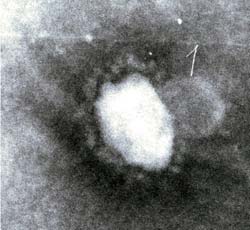How to stop SARS viruses from reproducing

The bright spot surrounded by a corona looks harmless, but it is a deadly pathogen: A corona virus causing SARS. The virus was first identified by the Bernhard Nocht Institute for Tropical Medicine in Hamburg. Picture by Bernhard Nocht Institute for Tropical Medicine.
From November 2002 to June 2003, 8,500 patients were infected with an at that time unknown pathogen originating in southern China; 800 humans died. Then, the epidemic was controlled and it’s cause detected. The pathogen was a novel corona virus. Such viruses are extremely alterable.
Now, researchers of the “Leibniz-Institut für Molekulare Pharmakologie” (FMP) in Berlin have synthesized substances that target a vital enzyme of the SARS virus, namely it’s main protease. “We were systematically looking for molecules to prevent the corona virus from reproducing itself”, says Prof. Jörg Rademann. He heads the group “Medical Chemistry” at the FMP. Rademann adds: “We hope that our research can help to produce suitable drugs against such viruses in a short time, especially in the case of a new epidemic.”
The main protease proved to be a good starting-point for the researchers: The group of Prof. Rolf Hilgenfeld at the University of Lübeck provided the protein and solved its structure. The viral enzyme cuts long protein molecules manufactured by the virus in the host cell into small pieces. The main protease is essential for the reproduction of all corona viruses and it has an almost identical structure in all of these pathogens. Thus, once a substance that attacks the main protease is found, scientists would have a wide range of possibilities to fight different corona viruses.
Rademann and his team, together with colleagues, have synthesized for the first time molecules that attach themselves to the main protease without being chemically reactive. Most importantly, this process is reversible, thus minimizing side-effects of potential drugs. The researchers presented a collection of substances that resemble the natural substrate of the main protease. Even if it is still a long way from such a collection to suitable drugs, the newly synthesized peptide aldehydes mark an important step towards a therapy for SARS. The next goal is to identify the most effective peptide aldehydes out of the collection and then to further optimize the substance. “If we are successful, the next outbreak of SARS will pose a much smaller threat to public-health and we will not be helpless”, says Rademann.
Media Contact
More Information:
http://www.fv-berlin.deAll latest news from the category: Life Sciences and Chemistry
Articles and reports from the Life Sciences and chemistry area deal with applied and basic research into modern biology, chemistry and human medicine.
Valuable information can be found on a range of life sciences fields including bacteriology, biochemistry, bionics, bioinformatics, biophysics, biotechnology, genetics, geobotany, human biology, marine biology, microbiology, molecular biology, cellular biology, zoology, bioinorganic chemistry, microchemistry and environmental chemistry.
Newest articles

Peptides on Interstellar Ice
A research team led by Dr Serge Krasnokutski from the Astrophysics Laboratory at the Max Planck Institute for Astronomy at the University of Jena had already demonstrated that simple peptides…

A new look at the consequences of light pollution
GAME 2024 begins its experiments in eight countries. Can artificial light at night harm marine algae and impair their important functions for coastal ecosystems? This year’s project of the training…

Silicon Carbide Innovation Alliance to drive industrial-scale semiconductor work
Known for its ability to withstand extreme environments and high voltages, silicon carbide (SiC) is a semiconducting material made up of silicon and carbon atoms arranged into crystals that is…





















